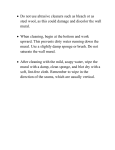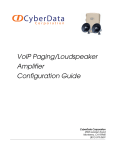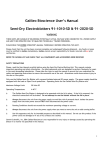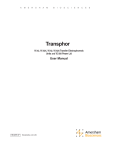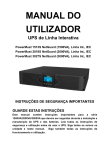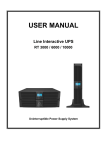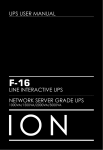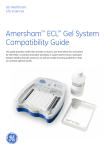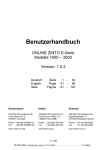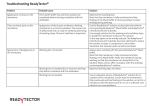Download Immobilon®-P Transfer Membrane User Guide
Transcript
® Immobilon -P Transfer Membrane User Guide Notice The information in this document is subject to change without notice and should not be construed as a commitment by Millipore Corporation. Millipore Corporation assumes no responsibility for any errors that may appear in this document. This manual is believed to be complete and accurate at the time of publication. In no event shall Millipore Corporation be liable for incidental or consequential damages in connection with or arising from the use of this manual. Millipore, Immobilon and Milli-Q are registered trademarks of Millipore Corporation. MilliBlot is a trademark of Millipore Corporation. Scotch Brite is a trademark of 3M Corporation. Tween is a registered trademark of ICI Americas Inc. Copyright 2007, Millipore Corporation. PR02531, Rev. A, 05/07 Contents Introduction .................................................................................................................... 1 How to Prepare an SDS-PAGE Gel and the Immobilon-P Membrane ................................... 2 Preparing the Gel ..................................................................................................... 2 Preparing the Membrane .......................................................................................... 3 How to Perform a Transfer with a Tank System .................................................................. 4 Preparing the Buffer for a Tank Transfer Assembly ....................................................... 4 Assembling the Transfer Stack for a Tank System ......................................................... 4 Transferring the Protein Using a Tank System .............................................................. 5 Removing the Blot from the Tank Transfer System ......................................................... 6 How to Perform a Transfer with a Semi-Dry System ........................................................... 6 Preparing the Buffers for a Semi-Dry Transfer Assembly .............................................. 7 Assembling the Transfer Stack for a Semi-Dry System (Single Transfer) ......................... 7 Assembling the Transfer Stack for a Semi-Dry System (Multiple Transfer) ....................... 9 Transferring the Protein Using a Semi-Dry System ..................................................... 10 Removing the Blot from the Semi-Dry System ............................................................ 10 How to Visualize the Proteins ......................................................................................... 11 Using Staining Methods .......................................................................................... 11 Using the Transillumination Method .......................................................................... 12 How to Dry the Blotted Membrane ................................................................................. 13 How to Perform a Rapid Immunodetection on Immobilon-P Membrane Without Blocking .... 14 Considerations for Protein Sequencing Applications ........................................................ 15 Glycine .................................................................................................................. 15 Coomassie Brilliant Blue Stain .................................................................................. 15 Additional Information .................................................................................................. 16 Storage .................................................................................................................. 16 Protein Elution ........................................................................................................ 16 Amino Acid Analysis .............................................................................................. 16 Low Molecular Weight Proteins ................................................................................ 16 Fluorescence Immunodetection ................................................................................. 17 Peptide Mapping .................................................................................................... 17 Hydrophobic Proteins .............................................................................................. 17 Guidelines for Choosing an Immobilon PVDF Membrane ................................................. 18 Ordering Information .................................................................................................... 19 Technical Assistance ...................................................................................................... 20 Standard Warranty ....................................................................................................... 20 Immobilon-P Transfer Membrane Introduction The Millipore Immobilon-P Transfer Membrane is a polyvinylidene fluoride (PVDF) microporous membrane for binding proteins that are transferred from a variety of gel matrices. This membrane is hydrophobic and offers a uniformly controlled pore structure with a high binding capacity for biomolecules. When compared to a nitrocellulose membrane, it has improved handling characteristics and staining capabilities, increased solvent resistance, and a higher signal-to-noise ratio for enhanced sensitivities. The Immobilon-P membrane has a nominal pore size of 0.45 micron (µm) and is useful for blotting proteins >10 kDa. It is an ideal substrate for immunodetection. The Immobilon-P membrane is compatible with standard blocking agents and detection protocols, including chemiluminescence. Because the membrane is composed of PVDF, it is also compatible with the harsh conditions used in protein sequencing and amino acid analysis. This insert describes how to perform electroblotting using a tank or semi-dry transfer system. It also provides steps on a new rapid immunodetection protocol and technical considerations for protein sequencing applications. NOTE: If proteins in the range of 10–20 kDa are to be electroblotted, Immobilon-P and Immobilon-PSQ membranes should both be evaluated to identify the membrane that will offer optimum detection. The Immobilon-PSQ membrane is recommended when electroblotting proteins <10 kDa. For more information, visit www.millipore.com/immunodetection or view the following at www.millipore.com: ■ RP562, “Rapid Immunodetection of Blotted Proteins without Blocking” ■ TN051, “Rapid Immunodetection Method on Immobilon-P Using Chemiluminescence” http://www.millipore.com/immobilon 2 How to Prepare an SDS-PAGE Gel and the Immobilon-P Membrane Before starting, have a sodium-dodecyl sulfate-polyacrylamide gel (SDS-PAGE gel) and a complex protein mixture available. Preparing the Gel 1. Resolve the protein mixture on the gel. The amount of protein loaded depends on the width of the wells, the dimensions of the gel, and the individual protein concentration in the sample. For optimum resolution, consider all these factors when loading. CAUTION: Do not overload the gel or the bands may smear during the transfer. For example, 10 to 20 microgram (µg) of a complex protein mixture in each 8-millimeter (mm) lane resolves well on a mini-gel. 2. Open the gel cassette and lift off the gel with a clean razor blade. Then notch a corner of the gel. This provides orientation to the membrane after the transfer. 3. Prepare 100 milliliter (mL) of the appropriate buffer solution for the transfer method. (Prepare 200 mL of buffer for larger gels.) This chart describes buffer compositions for wet tank and semidry transfer conditions: Transfer Method Buffer Composition Tank transfer Transfer buffer 25 millimolar (mM) Tris base, 192 mM glycine, 10% methanol Semi-dry transfer Cathode buffer 25 mM Tris base, 40 mM 6-amino-n-caproic acid, 10% methanol, pH 9.4 NOTE: Glycine may be substituted for 6-amino-n-caproic acid. 4. Immerse the gel in the transfer buffer and allow it to equilibrate for 15 minutes. 3 Immobilon-P Transfer Membrane Preparing the Membrane Before starting, have a piece of the Immobilon-P membrane, the prepared gel, methanol, and Milli-Q® water available. 1. Prepare 100 mL of transfer buffer for a tank transfer. For a semi-dry transfer, prepare 100 mL of anode buffer II. Transfer Method Buffer Composition Tank transfer Transfer buffer 25 mM Tris base, 192 mM glycine, 10% methanol Semi-dry transfer Anode buffer II 25 mM Tris, 10% methanol, pH 10.4 2. Cut a piece of the Immobilon-P membrane to the dimensions of the gel. Notch or label one corner of the membrane to correspond to a corner of the gel. 3. Wet the membrane in 100% methanol for 15 seconds. Then transfer it to a container of Milli-Q water for 2 minutes. CAUTION: Use care when handling the membrane to prevent tearing. Do not leave any dry spots that can inhibit the transfer. 4. Equilibrate the membrane for at least 5 minutes in the transfer buffer for a tank transfer or in the anode buffer II solution for a semi-dry transfer. NOTE: For alternative buffer systems, equilibrate the membrane in the buffer of choice. 5. Follow the steps in the next section for a tank transfer system. For a semi-dry system, see the “How to Perform a Semi-Dry Transfer” section instead. http://www.millipore.com/immobilon 4 How to Perform a Transfer with a Tank System Steps to transfer proteins from gels using a tank transfer system: ■ Prepare the buffer ■ Assemble the transfer stack ■ Transfer the protein ■ Remove the blot Preparing the Buffer for a Tank Transfer Assembly Buffer Composition Amount Tank transfer 25 mM Tris base, 192 mM glycine, 10% methanol A volume sufficient to fill the transfer tank. Assembling the Transfer Stack for a Tank System Materials required: ■ One tank transfer system ■ Two foam pads (for example, Scotch Brite® pads) ■ Two sheets of blotting filter paper, cut to the dimension of the gel and soaked in tank transfer buffer for at least 30 seconds ■ One glass pipette ■ Transfer buffer ■ One prepared gel ■ One prepared sheet of Immobilon-P membrane 5 Immobilon-P Transfer Membrane Assembling the Transfer Stack for a Tank System, continued 1. Place a foam pad on one side of the cassette holder. Then place one sheet of filter paper on top of the pad. CAUTION: To ensure an even transfer, remove air bubbles by carefully rolling a pipette over the surface of each layer in the stack. Applying excessive pressure may damage the membrane and gel. 2. Place the gel on top of the filter paper. Then put the sheet of the Immobilon-P membrane on top of the gel. 3. Place one sheet of filter paper on top of the stack. Then put a foam pad on top of the filter paper. The stack should look like this: Foam pad, one sheet Filter paper, one sheet Immobilon-P membrane Gel Filter paper, one sheet Foam pad, one sheet Transferring the Protein Using a Tank System 1. Close the tank transfer cassette holder. Then place it in the tank blotting apparatus so that the side of the cassette holder with the gel is facing the cathode (-). Add enough transfer buffer to the blotting apparatus to cover the cassette holder. 2. Insert the black cathode lead (-) into the cathode jack. Insert the red anode lead (+) into the anode jack. Then connect the anode lead and cathode lead to their corresponding power outputs. 3. Turn on the system for 1 to 2 hours at 6 to 8 V/cm inter-electrode distance to transfer the proteins to the membrane. The buffer may need to be cooled during the transfer to prevent overheating. 6 http://www.millipore.com/immobilon Removing the Blot from the Tank Transfer System 1. Remove the cassette holder from the blotting apparatus. Open the cassette holder. Remove the foam pad and filter papers with forceps. NOTE: Let the blot air-dry to improve the protein binding. 2. See the “How to Visualize the Proteins” section further in this document for details on staining. If performing traditional immunodetection with blocking, the membrane must be rewet with methanol and rinsed with water, before putting the membrane in the blocking solution. To visualize the proteins with transillumination or perform a rapid immunodetection, see the “How to Dry the Blotted Membrane” section near the end of this document. CAUTION: Before performing transillumination or rapid immunodetection techniques, the Immobilon-P membrane must be dried for specific lengths of time. (See the chart in “How to Dry the Blotted Membrane” section for time details.) The drying enhances protein binding to the surface and reduces background noise. How to Perform a Transfer with a Semi-Dry System Steps to transfer proteins from gels using a semi-dry system: ■ Prepare the buffers ■ Assemble the transfer stack for a single or multiple transfer ■ Transfer the protein ■ Remove the blot Immobilon-P Transfer Membrane 7 Preparing the Buffers for a Semi-Dry Transfer Assembly Prepare anode buffer I, anode buffer II, and cathode buffer solutions: Buffer Composition Amount Anode buffer I 0.3 M Tris, 10% methanol, pH 10.4 200 mL Anode buffer II 25 mM Tris, 10% methanol, pH 10.4 25 mM Tris base, 40 mM, 6-amino-n-caproic acid, 10% methanol, pH 9.4 NOTE: Glycine may be substituted for 6-amino-n-caproic acid. 200 mL Cathode buffer 200 mL Continue to the next section to assemble a stack for a single transfer. For a multiple transfer, see “Assembling the Transfer Stack for a Semi-Dry System (Multiple Transfer).” Assembling the Transfer Stack for a Semi-Dry System (Single Transfer) Materials needed to assemble the transfer stack: ■ One semi-dry blotter ■ Six sheets of blotting filter paper cut to the gel dimensions ■ One sheet of prepared Immobilon-P membrane ■ One prepared gel ■ Prepared anode and cathode buffers 8 http://www.millipore.com/immobilon Assembling the Transfer Stack for a Semi-Dry System (Single Transfer), continued 1. Place the anode electrode plate on a level bench top. Then wet two sheets of filter paper in the anode buffer I solution. Place them in the center of the graphite anode electrode plate. CAUTION: To ensure an even transfer, remove air bubbles by carefully rolling a pipette over the surface of each layer of the stack. Applying excessive pressure may damage the membrane and gel. 2. Wet a sheet of filter paper in the anode buffer II solution. Place it on top of the first two sheets of filter paper. Place the Immobilon-P membrane on top of the filter paper. 3. Place the gel on top of the membrane. Wet three pieces of filter paper in the cathode buffer solution. Place them on top of the gel. 4. Place the cathode plate cover on top of the assembled transfer stack. The stack should look like this: Cathode electrode plate Filter paper wetted in cathode buffer, three sheets Gel Immobilon-P membrane Filter paper wetted in anode buffer II, one sheet Filter paper wetted in anode buffer I, two sheets Anode electrode plate CAUTION: Do not bump the cathode plate cover since it could disturb the alignment of the transfer stack and cause inaccurate results. 5. Continue to “Transferring the Protein Using a Semi-Dry System.” Immobilon-P Transfer Membrane 9 Assembling the Transfer Stack for a Semi-Dry System (Multiple Transfer) This section describes how to assemble a transfer stack for a semi-dry system. Up to six gels may be transferred in a single stack. 1. Locate the materials listed in the previous section “Assembling the Transfer Stack for a Semi-Dry System (Single Transfer).” Additional materials needed include: ■ Dialysis membrane, for multiple transfer stacks, cut to the dimensions of the gel and wet in Milli-Q water NOTE: The dialysis membrane should have a molecular weight exclusion small enough to retain the lowest molecular weight protein in the gel. ■ Blotting filter sheets cut to the dimensions of the gel 2. Follow steps 1 and 2 from “Assembling the Transfer Stack for a Semi-Dry System (Single Transfer).” 3. Place the gel on top of the membrane. 4. Wet a sheet of filter paper, cut to the dimensions of the gel, in cathode buffer. Then place it on top of the gel. NOTE: If you finished adding the last gel to the stack, place two pieces of filter paper, soaked in cathode buffer, on top of the stack. Then skip to step 9. If more gels need to be added to the stack, continue on to step 5. 5. Place a piece of dialysis membrane on top of the filter paper. 6. Wet a sheet of filter paper in anode buffer II and place it on top of the dialysis membrane. 7. Place a sheet of Immobilon-P membrane on top of the filter paper. 8. Return to step 3 to build another transfer stack. 9. Place the cathode plate cover on top of the assembled transfer stack. Then continue to “Transferring the Protein Using a Semi-Dry System.” http://www.millipore.com/immobilon 10 Transferring the Protein Using a Semi-Dry System 1. Insert the black cathode lead (-) into the cathode plate jack. Then insert the red anode lead (+) into the anode plate jack. 2. Connect the anode lead and cathode lead to their corresponding power supply outputs. 3. Turn on the power supply. Set the current and let it run for the appropriate time: Current Density Time Limit 0.8 mA/cm2 1 to 2 hours 1.2 mA/cm2 1 hour 2.5 mA/cm2 30 to 45 minutes 4.0 mA/cm2 10 to 30 minutes Removing the Blot from the Semi-Dry System 1. Turn off the power supply and disconnect the system leads when the transfer is complete. 2. Remove the cover. Then peel off and discard the filter papers. 3. Peel off the gel. 4. Peel off the blotted membrane with a pair of forceps. 5. See the next section, “How to Visualize the Proteins,” for details on staining. To visualize the proteins with transillumination or perform a rapid immunodetection, see “How to Dry the Blotted Membrane” further in this document. CAUTION: Completely dry the Immobilon-P membrane for specific lengths of time before performing transillumination or rapid immunodetection techniques. (See the chart in “How to Dry the Blotted Membrane” section for time details.) The drying enhances protein binding to the surface and reduces background noise. Immobilon-P Transfer Membrane 11 How to Visualize the Proteins Once the electrotransfer is complete, the blot may be stained to assess the quality of the transfer using a stain such as Coomassie brilliant blue R, amido black, or Ponceau-S red. If the stain could interfere with subsequent analysis, use transillumination to visualize the proteins. (To determine protein elution from the gel, stain it with Coomassie brilliant blue or a silver stain.) See the following section for details on staining. Skip to “Using Transillumination” for details on transillumination. Using Staining Methods This section describes how to stain with: ■ Coomassie brilliant blue R ■ Amido black ■ Ponceau-S red For details on visualizing proteins with transillumination, see the “How to Visualize with Transillumination: section. CAUTION: If Coomassie brilliant blue R, amido black, or Ponceau-S red stain will be used to visualize the proteins and the blot is dry, re-wet it in 100% methanol before staining it to ensure accurate results. Coomassie Brilliant Blue R Stain To stain the blot with Coomassie blue, follow these steps. CAUTION: This stain will interfere with rapid immunodetection. It is not reversible. Follow the steps in the “Ponceau-S Red Stain” section or “How to Visualize with Transillumination” for reversible methods. 1. Incubate the blot in a solution of 0.1% Coomassie brilliant blue R in 50% methanol, 7% acetic acid, for 2 minutes. 2. Destain the blot in 50% methanol, 7% acetic acid, for 10 minutes. 3. Incubate the blot in 90% methanol, 10% acetic acid for 10 minutes to completely destain the background. 12 http://www.millipore.com/immobilon Amido Black Stain To stain the blot with amido black, follow these steps. CAUTION: This stain will interfere with rapid immunodetection. It is not reversible. Follow the steps in the “Ponceau-S Red Stain” section or “How to Visualize with Transillumination” for reversible techniques. 1. Incubate the blot in a solution of 0.1% amido black in 25% isopropanol, 10% acetic acid for 10 minutes. 2. Destain the blot in the same buffer without amido black for 5 to 10 minutes. Ponceau-S Red Stain To stain the blot with Ponceau-S red (reversible stain), follow these steps. 1. Stain the blot in a solution of 0.5% Ponceau-S red, 1% acetic acid, for 1 minute. 2. Destain the blot in Milli-Q grade water to the desired contrast or wash the blot with NaOH to remove the stain completely. 0.1 N Using the Transillumination Method Transillumination is a nondestructive, reversible method of determining the presence of the appropriate protein pattern. To perform transillumination on the blot, follow these steps: 1. Let the blot dry completely using one of the drying methods listed in the following section, “How to Dry the Blotted Membrane.” Then return to this section. 2. Immerse the dry blot in 20% methanol for 2 minutes. 3. Place the blot on a light box and mask the areas around the blot with a sheet of black paper. The bands appear as clear areas against an opaque background. NOTE: Detection sensitivity is comparable to Coomassie brilliant blue R. 13 Immobilon-P Transfer Membrane How to Dry the Blotted Membrane After removing the blotted membrane from a tank or semi-dry system, it must be dried before continuing on to any transillumination or rapid immunodetection procedures to ensure optimum results. This section lists four drying options. The length of time for each option varies. As the blot dries, it becomes opaque. Wait the full length of drying time for all of the liquid to evaporate from within the membrane’s pore structure. CAUTION: Thoroughly drying the blot is especially crucial if performing a rapid immunodetection without blocking. If the blot is not dry, any residual water trapped in the pores will cause the membrane to wet out during the procedure, increasing background noise. To dry the membrane after blotting, select one of these methods: Drying Method Option Soak the membrane in 100% methanol for 10 seconds to drive out the water. Then place the blot on a piece of filter paper. Wait for the methanol to evaporate. Place the blot in a vacuum chamber. (Secure the blot between two sheets of filter paper.) Incubate the blot at 37 °C. Place the blot on a lab bench to let it dry at room temperature. Required Drying Time 15 minutes 30 minutes 1 hour 2 hours See the next section to perform a rapid immunodetection or see the previous section on using transillumination. 14 http://www.millipore.com/immobilon How to Perform a Rapid Immunodetection on Immobilon-P Membrane Without Blocking In immunodetection, a specific antibody identifies the location of a membrane-bound antigen. Immunodetection on Immobilon-P membrane does not require blocking or lengthy wash steps if you thoroughly dry the membrane after protein transfer; drying the membrane returns it to its hydrophobic state. Antibodies can then bind specifically to the proteins on the membrane surface, but not to the membrane itself, eliminating the blocking step. NOTE: Depending on the antibody source and detection system, adjustments may need to be made to the buffer composition and incubation times. The following procedure is a general overview of the Rapid Immunodetection Procedure utilizing chromogenic detection. Refer to Millipore publication RP562, “Rapid Immunodetection of Blotted Proteins without Blocking” for a more detailed chromogenic detection protocol. Millipore publication TN051, “Rapid Immunodetection Method on Immobilon-P Using Chemiluminescence” details the chemiluminescence detection protocol. 1. Dry the blotted membrane using one of the methods listed in the previous section. CAUTION: Thoroughly drying the blot is especially crucial if planning to perform a rapid immunodetection without blocking. If the blot is not dry, any residual water trapped in the pores will cause the membrane to wet out during the procedure, increasing background noise. 2. Incubate the blot for 1 hour with a primary antibody diluted in blocking buffer that contains 0.05% Tween®-20 wetting agent. (Blocking buffer consists of 1% BSA in phosphate-buffered saline [PBS]: 10 mM Na-phosphate, pH 7.2, 0.9% NaCl.) 3. Wash the blot in PBS two times for 10 seconds. CAUTION: Exceeding the recommended concentration of detergent or the indicated wash times may reduce the signal-to-noise ratio. 4. Incubate the blot for 30 minutes with a secondary antibody diluted in blocking buffer containing 0.05% Tween-20 wetting agent. Immobilon-P Transfer Membrane 15 How to Perform a Rapid Immunodetection on Immobilon-P Membrane Without Blocking, continued 5. Wash the blot in PBS two times for 10 seconds. 6. Add the substrate to the blot and incubate it until the signal reaches the desired contrast. Then wash the blot in Milli-Q water to stop the reaction. 7. Air-dry the membrane and store it in a dark place. Considerations for Protein Sequencing Applications Protein sequencing provides valuable amino acid sequence information; N-terminal sequencing is commonly performed by automated instruments designed for this purpose. The following sections provide information on the most common concerns about using the Immobilon-P membrane for sequencing applications. Glycine Glycine present in standard transfer buffers leads to a high background glycine peak in the first few cycles of protein sequencing and in amino acid analysis. To reduce the glycine level, wet the membrane in 100% methanol and then wash extensively with Milli-Q system water. Alternatively, change the transfer buffer to 10 mM CAPS (3-[cyclohexylamino]-1-propanesulfonic acid), pH 11, 10% methanol. This buffer works well in tank transfer systems, but may give less efficient transfer in semi-dry systems. Coomassie Brilliant Blue Stain Coomassie brilliant blue is compatible with automated protein sequencing chemistries. In general, if the protein band or spot can be visualized by Coomassie staining, there is enough protein for sequencing. 16 http://www.millipore.com/immobilon Additional Information Storage For long-term storage, dry the blot completely, then seal it in a plastic bag. Place the bag between two sheets of cardboard. Store the assembly at -20 °C or colder to prevent oxidation. The cardboard protects the frozen membrane from breaks or cracks due to handling when removing the membrane from storage. Allow the membrane to thaw to ambient temperature before removing the cardboard. Protein Elution For applications requiring protein elution from the membrane, visualize the proteins bands by transillumination or Coomassie staining in solutions free of acetic acid. The acid in staining solutions strengthens the interaction between proteins and the membrane, making elution more difficult. Amino Acid Analysis For amino acid analysis, always analyze a piece of blank membrane from the same blot to account for any background signals. Low Molecular Weight Proteins Proteins with a molecular weight <10 kDa often pass through Immobilon-P membrane during electroblotting; this makes it more difficult to obtain sequence information. For low molecular weight proteins, Millipore recommends the Millipore Immobilon-PSQ membrane. Its smaller pore size and higher internal surface area result in near-quantitative capture of low molecular weight proteins. Immobilon-PSQ membrane is composed of pure PVDF and is fully compatible with protein sequencing. If proteins in the range of 10–20 kDa are to be electroblotted, both Immobilon-P and Immobilon-PSQ membranes should be evaluated for optimum detection. Immobilon-P Transfer Membrane 17 Fluorescence Immunodetection Fluorescence-based immunodetection is often hindered by high autofluorescence of the blotting membrane. Immobilon-FL 0.45 µm PVDF transfer membrane exhibits very low autofluorescence across a wide range of excitation/emission wavelengths in both visible and IR ranges. This property makes it ideal for any application involving fluorescence-based immunodetection. Peptide Mapping Although Immobilon-P membrane may be used for peptide mapping by in situ cleavage, hydrophobic peptides often adhere to the membrane surface. Hydrophobic Proteins For electrophoresis of hydrophobic proteins (for example, membrane-bound proteins), detergents are essential for good resolution and solubility. But including the detergent in the transfer buffer prevents the protein from binding to the Immobilon-P membrane. Removal of the detergent before electrotransfer often results in protein precipitation in the gel. If detergent must be included in the transfer buffer to provide good transfer, Millipore recommends the Immobilon-PSQ membrane for better results when binding hydrophobic proteins. The smaller pore size and higher internal surface area of the Immobilon-PSQ membrane improves the chances of the protein binding to the membrane. NOTE: The following sections contain details on choosing the right Immobilon membrane for your application and ordering information. 18 http://www.millipore.com/immobilon Guidelines for Choosing an Immobilon PVDF Membrane This chart lists the membrane of choice for most proteins in specific applications after a western blot. But because of varying protein properties such as charge density, conformation, and hydrophobicity, all proteins do not behave the same way on a membrane surface. Keep in mind that the chart below lists only guidelines. Experiments with a variety of Immobilon membranes may be neccessary to optimize results for your specific application. Application (After Western Blotting) General immunodetection Amino acid analysis Immunodetection of low molecular weight or low-abundance proteins Sequencing of low molecular weight or low-abundance proteins Fluorescence immunodetection and chemifluorescence methods Membrane of Choice (Most Proteins) Immobilon-P Immobilon-P Immobilon-PSQ Immobilon-PSQ Immobilon-FL 19 Immobilon-P Transfer Membrane Ordering Information This section lists the catalogue numbers for Immobilon-P, Immobilon-PSQ and Immobilon-FL membranes. See the Technical Assistance section for information about contacting Millipore Corporation. Immobilon-P Membrane (0.45 µm pore size) Type Membrane Dimensions Roll Cut Sheet 26.5 cm × 375 cm 26 cm × 26 cm 20 cm × 20 cm 15 cm × 15 cm 10 cm × 10 cm 9 cm × 12 cm 8.5 × 13.5 cm 8 × 10 cm 7 cm × 8.4 cm Qty/Pk Catalogue Number 1 10 10 10 10 10 10 10 50 IPVH 000 10 IPVH 304 F0 IPVH 202 00 IPVH 151 50 IPVH 101 00 IPVH 091 20 IPVH 081 30 IPVH 081 00 IPVH 078 50 Qty/Pk Catalogue Number 1 10 10 10 10 10 10 10 50 ISEQ 000 10 ISEQ 262 60 ISEQ 202 00 ISEQ 151 50 ISEQ 101 00 ISEQ 091 20 ISEQ 081 30 ISEQ 081 00 ISEQ 078 50 Immobilon-PSQ Membrane (0.2 µm pore size) Type Membrane Dimensions Roll Cut Sheet 26.5 cm × 375 cm 26 cm x 26 cm 20 cm x 20 cm 15 cm x 15 cm 10 cm x 10 cm 9 cm × 12 cm 8.5 × 13.5 cm 8 × 10 cm 7 cm × 8.4 cm Immobilon-FL Membrane (0.45 µm pore size) Type Membrane Dimensions Roll Cut Sheet 26 cm × 375 cm 20 × 20 cm 10 × 10 cm Qty/Pk Catalogue Number 1 10 10 IPFL 000 10 IPFL 202 00 IPFL 101 00 Technical Assistance For more information, contact the Millipore office nearest you. In the U.S., call 1-800-MILLIPORE (1-800-645-5476). Outside the U.S., see your Millipore catalogue for the phone number of the office nearest you or go to our web site at www.millipore.com/offices for up-to-date worldwide contact information. You can also visit the tech service page on our web site at http://www.millipore.com/ techservice. Standard Warranty Millipore Corporation (“Millipore”) warrants its products will meet their applicable published specifications when used in accordance with their applicable instructions for a period of one year from shipment of the products. MILLIPORE MAKES NO OTHER WARRANTY, EXPRESSED OR IMPLIED. THERE IS NO WARRANTY OF MERCHANTABILITY OR FITNESS FOR A PARTICULAR PURPOSE. The warranty provided herein and the data, specifications and descriptions of Millipore products appearing in Millipore's published catalogues and product literature may not be altered except by express written agreement signed by an officer of Millipore. Representations, oral or written, which are inconsistent with this warranty or such publications are not authorized and if given, should not be relied upon. In the event of a breach of the foregoing warranty, Millipore's sole obligation shall be to repair or replace, at its option, the applicable product or part thereof, provided the customer notifies Millipore promptly of any such breach. If after exercising reasonable efforts, Millipore is unable to repair or replace the product or part, then Millipore shall refund to the customer all monies paid for such applicable product or part. MILLIPORE SHALL NOT BE LIABLE FOR CONSEQUENTIAL, INCIDENTAL, SPECIAL OR ANY OTHER INDIRECT DAMAGES RESULTING FROM ECONOMIC LOSS OR PROPERTY DAMAGE SUSTAINED BY ANY CUSTOMER FROM THE USE OF ITS PRODUCTS.
























